I am making an text based rpg/adventure game and i want to add some ASCII art. I have used triple quotation marks for a multiline string like so:
print("""
/\ /\ /\ /\
/**\ /**\ /**\ /**\
/****\ /\ /\ /****\ /\ /****\ /\ /\ /****\ /\
/ \ /**\ / \ / \ /**\ / \ /**\ / \ / \ /**\
/ /\ / \ / \ / /\ / \ /\ / /\ / \ / \ / /\ / \
/ / \ / \/ \/ / \ / \ / \ / / \ / \/ \/ / \ / \
/ / \/ /\ \ / / \/ /\ \/ \/ / \/ /\ \ / / \/ /\ \
/ / \/ \/\ \ / / \/ \/\ \ / / \/ \/\ \ / / \/ \/\ \
__/__/_______/___/__\___\__/__/_______/___/__\___\___/__/_______/___/__\___\__/__/_______/___/__\___\_
""")
Ideally, this is what it should look like when i run the program.
However, it looks like this instead which is not ideal at all and looks extremely messy:
I was wondering if anyone could point me in the right direction on how to go about this problem. Thanks in advance!
